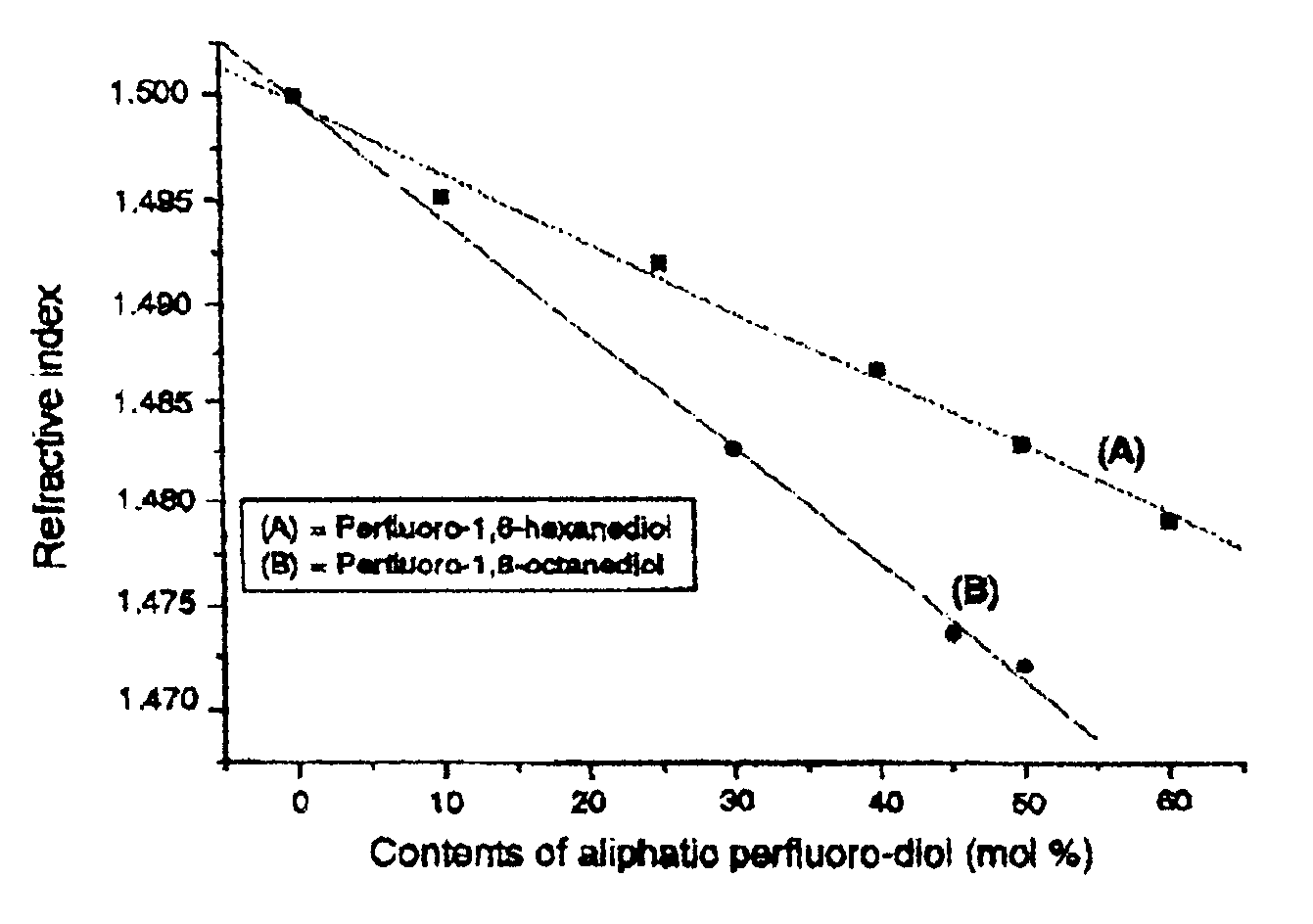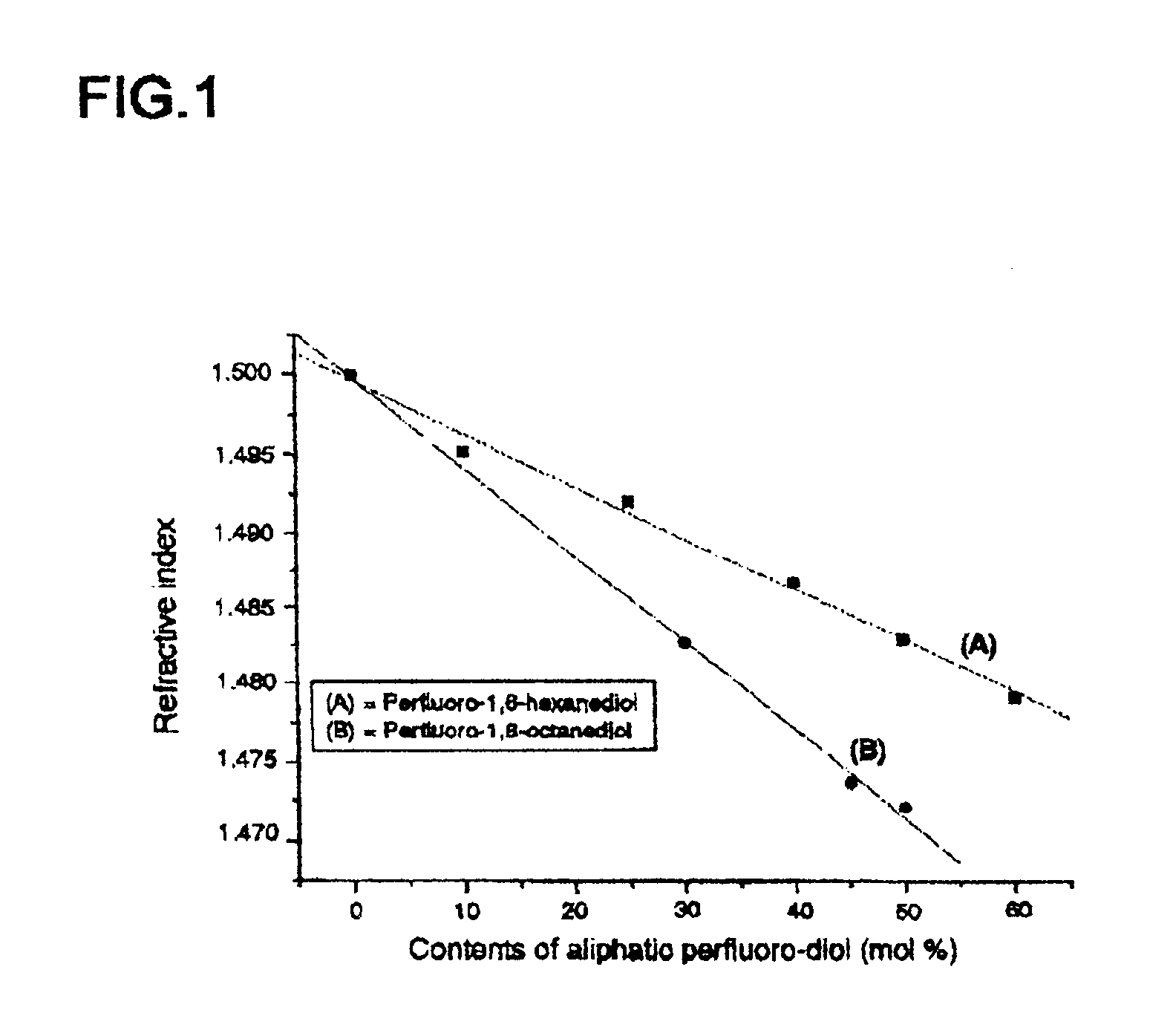Fluorinated polyethers having perfluorinated aliphatic group and optical waveguide using the same
- Summary
- Abstract
- Description
- Claims
- Application Information
AI Technical Summary
Benefits of technology
Problems solved by technology
Method used
Image
Examples
example 1
Preparation of a Polymer Having the Repeat Unit Represented by a Formula (A)
[0046]5.0 g (14.965 mmol) of decafluorobiphenyl and 3.84 g (14.965 mmol) of octafluoro-1,6-hexanediol are introduced into a 100 mL three-necked flask, and then completely dissolved in 50 mL of a DMAc solvent. 5.26 g of K2CO3 is added into the reaction flask, and the resulting mixture is heated to 80° C. under a nitrogen atmosphere and stirred for 24 hours. Then, the reaction mixture is cooled and precipitated in a mixed solution of methanol and DI water. The produced polymer is filtrated and washed continuously with water. The obtained polymer is dried in a vacuum oven at 80° C.
[0047]1H-NMR (Acetone d6): δ 5.04 (t, 4H, —CH2O—). Mn=22,600; PDI=2.7; thermal decomposition temp. (Td)=400° C.
example 2
Preparation of a Polymer Having the Repeat Unit Represented by the Formula (D)
[0048]5.0 g (26.9 mmol) of hexafluorobenzene and 7.1 g (26.9 mmol) of octafluoro-1,6-hexanediol are introduced into a 100 mL three-necked flask and completely dissolved in 55 mL of a DMAc solvent. 9.6 g of K2CO3 is added into the reaction flask, and the resulting mixture is heated to 80° C. under a nitrogen atmosphere and stirred for 24 hours. Subsequently, the stirred mixture is further heated up to 120° C. and reacted for 48 hours. After this, the reaction mixture is cooled and precipitated in a mixed solution of methanol and DI water. The produced polymer is filtered and washed continuously with water. The obtained polymer is dried in a vacuum oven at 80° C. 1H-NMR (Acetone d6): δ 4.6 (t, 4H, —CH2O—). Mn=12,400; PDI=3.1; thermal decomposition temp. (Td)=380° C.
example 3
Preparation of Polymer Having the Repeat Unit Represented by the Formula (G)
[0049]5.0 g (14.965 mmol) of decafluorobiphenyl and 4.4 g (14.965 mmol) of perfluorotriethylene glycol are introduced into a 100 mL three-necked flask and completely dissolved in 50 mL of a DMAc solvent. 5.26 g of K2CO3 is added into the reaction flask, and the resulting mixture is heated to 80° C. under a nitrogen atmosphere and stirred for 24 hours. The reaction mixture is cooled and precipitated in a mixed solution of methanol and DI water. The produced polymer is filtered and continuously washed with water. The obtained polymer is dried in a vacuum oven at 80° C. 1H-NMR (Acetone d6): δ 5.2 (t, 4H, —CH2O—); Mn=25,300; PDI=2.0; thermal decomposition temp. (Td)=420° C.
PUM
 Login to View More
Login to View More Abstract
Description
Claims
Application Information
 Login to View More
Login to View More - R&D
- Intellectual Property
- Life Sciences
- Materials
- Tech Scout
- Unparalleled Data Quality
- Higher Quality Content
- 60% Fewer Hallucinations
Browse by: Latest US Patents, China's latest patents, Technical Efficacy Thesaurus, Application Domain, Technology Topic, Popular Technical Reports.
© 2025 PatSnap. All rights reserved.Legal|Privacy policy|Modern Slavery Act Transparency Statement|Sitemap|About US| Contact US: help@patsnap.com



